NCERT Notes For Class 6 Maths Chapter 10 Mensuration Introduction
When we talk about some plane figures as shown below we think of their regions and their boundaries. We need some measures to compare them. We are looking into these now.

Perimeter
Look at the following figures. You can make them with a wire or a string.
If you start from point S in each case and move along the line segments then you again reach point S. You have made a complete round of the shape in each ease (1), (2) and (3). The distance covered is equal to the length of the wire used to draw the figure.
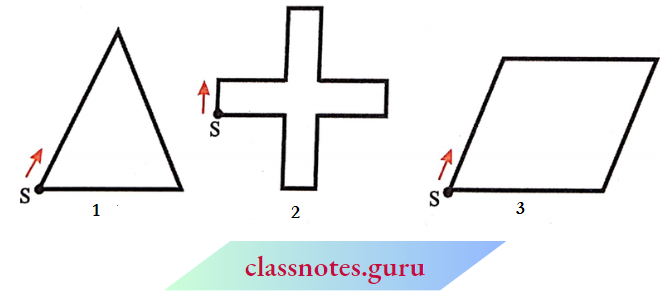
This distance is known as the perimeter of the closed figure. It is the length of the wire needed to form the figures.
Read and Learn More NCERT Notes for Class 6 Maths
The idea of perimeter is widely used in our daily life.
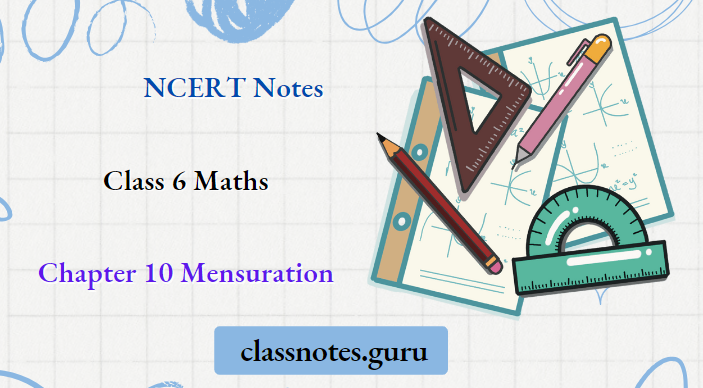
- A farmer who wants to fence his field.
- An engineer who plans to build a compound wall on all sides of a house.
- A person preparing a track to conduct sports.
All these people use the idea of ‘perimeter’.
Give five examples of situations where you need to know the perimeter.
Perimeter is the distance covered along the boundary forming a closed figure when you go around the figure once.
So, how will you find the perimeter of any closed figure made up entirely of line segments? Simply find the sum of the lengths of all the sides (which are line segments).
NCERT Notes For Class 6 Maths Perimeter Of A Rectangle
Let us consider a rectangle ABCD whose length and breadth are 15 cm and 9 cm g respectively.
What will be its perimeter?
The perimeter of the rectangle is = Sum of the lengths of its four sides.
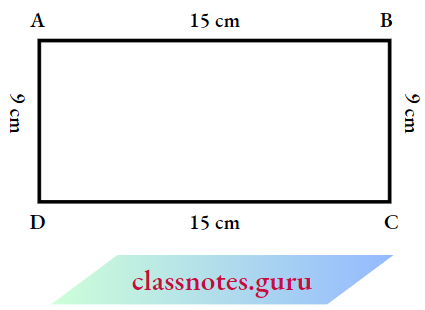
= AB + BC + CD + DA
= AB + BC + AB + BC
= 2 x AB + 2 x BC
= 2 x (AB + BC)
= 2 x (15cm + 9cm)
= 2 x (24cm)
= 48 cm
Hence, from the said example, we notice that
Perimeter of a rectangle = length + breadth + length + breadth
i.e. Perimeter of a rectangle = 2 x (length + breadth)
Let us now see the practical applications of this idea :
Example 1. Shabana wants to put a lace border all around a rectangular table cover, 3 m long and 2 m wide. Find the length of the lace required by Shabana.
Solution:
Length of the rectangular table cover = 3 m
The breadth of the rectangular table cover = 2 m
Shabana wants to put a lace border all around the table cover.
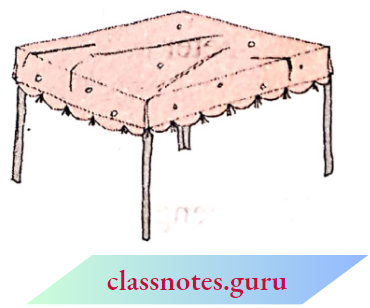
Therefore, the length of the lace required will be equal to the perimeter of the rectangular table cover.
Now, perimeter of the rectangular table cover = 2 x (length + breadth) = 2x(3m + 2m) = 2x5m=10m
So, the length of the lace required is 10 m.
Example 2. An athlete takes 10 rounds of a rectangular park, 50 m long and 25 m wide. Find the total distance covered by him.
Solution: Length of the rectangular park = 50 m
The breadth of the rectangular park = 25 m
The total distance covered by the athlete in one round will be the perimeter of the park.
Now, perimeter of the rectangular park = 2 x (length + breadth) = 2 x (50 m + 25 m)
= 2 x 75 m =150 m
So, the distance covered by the athlete in one round is 150 m.
Therefore, the distance covered in 10 rounds =10xl50m = 1500m The total distance covered by the athlete is 1500 m.
Example 3. Find the perimeter of a rectangle whose length and breadth are 150 cm and 1 m respectively.
Solution: Length = 150 cm
Breadth = lm = 100 cm
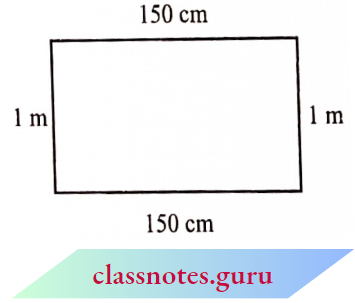
Perimeter of the rectangle = 2 x (length + breadth)
= 2 x (150 cm + 100 cm)
= 2 x (250 cm) = 500 cm = 5 m
Example 4. A farmer has a rectangular field of length and breadth of 240 m and 180 m respectively. He wants to fence it with 3 rounds of rope as shown. What is the total length of rope he must use?
Solution: The farmer has to cover three times the perimeter of that field.
Therefore, the total length of rope required is thrice its perimeter.
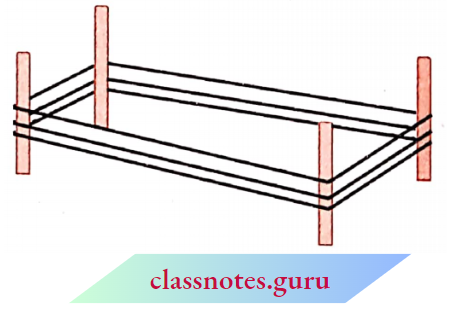
Perimeter of the field = 2 x (length + breadth)
= 2 x (240 m+ 180 m)
= 2 x 420 m = 840 m
Total length of rope required = 3 x 840 m = 2520 m
Example 5. Find the cost of fencing a rectangular park of length 250 m and breadth 175 ra at the rate of ₹ 12 per m
Solution: Length of the rectangular park = 250 m
The breadth of the rectangular park = 175 m
To calculate the cost of fencing we require a perimeter
Perimeter of the rectangle = 2 x (length + breadth)
= 2 x (250 m + 175 m)
= 2 x (425 m) = 850 m
Cost of fencing lm of park = ₹ 12
Therefore, the total cost of fencing the park = ₹12 x 850 = ₹ 10200
NCERT Notes For Class 6 Maths Perimeter Of Regular Shapes
Consider this example.
Biswamitra wants to put coloured tape all around a square picture of the side lm as shown. What will be the length of the coloured tape he requires?
Since Biswamitra wants to put the coloured tape all around the square picture, he needs to find the perimeter of the picture frame.
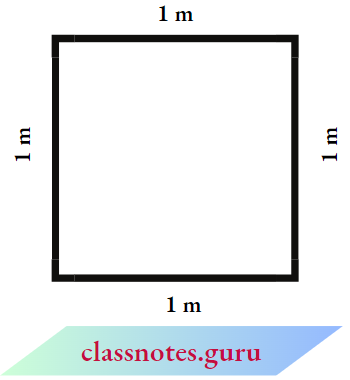
Thus, the length of the tape required
= Perimeter of square = 1m + 1m + 1m + 1m = 4m
Now, we know that all the four sides of a square are equal, therefore, in place of adding it four times, we can multiply the length of one side by 4.
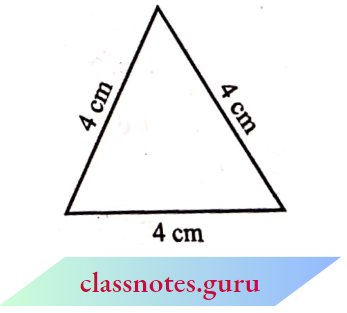
Thus, the length of the tape required = 4 x 1m = 4m
From this example, we see that
The perimeter of a square = 4 x length of a side
Draw more such squares and find the perimeters.
Now, look at an equilateral triangle with each side equal to 4 cm.
Can we find its perimeter?
Perimeter of this equilateral triangle = 4 + 4 + 4 cm = 3 x 4 cm = 12 cm
So, we find that
The perimeter of an equilateral triangle = 3 x the length of a side
What is similar between a square and an equilateral triangle?
They are figures having all the sides of equal length and all angles of equal measure Such figures are known as regular closed figures. Thus, a square and an equilateral triangle are regular closed figures,
You found that,
Perimeter of a square = 4 x length of one side
The perimeter of an equilateral triangle = 3 x the length of one side
Example 6. Find the distance travelled by Shaina if she takes three rounds of a square park of side 70 m.
Solution: Perimeter of the square park = 4 x length of a side = 4 x 70 m = 280 m
Distance covered in one round = 280 m
Therefore, distance travelled in three rounds=3 x 280m = 840m
Example 7. Pinky runs around a square field of side 75 m, Bob runs around a rectangular field with a length of 160 m and a breadth of 105 m. Who covers more distance and by how much?
Solution: Distance covered by Pinky in one round
= Perimeter of the square
= 4 x length of a side
= 4×75 m = 300m
Distance covered by Bob in one round
= Perimeter of the rectangle
= 2 x (length + breadth) = 2 x (160 m + 105 m)
= 2 x 265 m = 530 m
Difference in the distance covered = 530 m – 300 m = 230 m.
Therefore, Bob covers more distance by 230 m.
Example 8. Find the perimeter of a regular pentagon with each side measuring 3 cm.
Solution: This regular closed figure has 5 sides, each with a length of 3 cm.
Thus, we get Perimeter of the regular pentagon = 5 x 3 cm = 15 cm
Example 9. The perimeter of a regular hexagon is 18 cm. How long is it on one side?
Solution: Perimeters 18 cm
A regular hexagon has 6 sides, so we can divide the perimeter by 6 to get the length of one side.
One side of the hexagon = 18 cm -f 6 = 3 cm
Therefore, the length of each side of the regular hexagon is 3 cm.
Area
Look at the closed figures given below. All of them occupy some region of a flat surface.
Can you tell which one occupies more region?
The amount of surface enclosed by a closed figure is called its area.

So, can you tell, which of the above figures has more area?
Now, look at the adjoining figures.
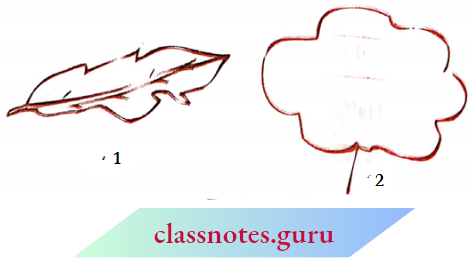
Which one of these has a larger area? It is difficult to tell just by looking at these figures. So, what do you do?
Place them on a squared paper or graph paper where every square measures 1 cm x 1 cm.
Make an outline of the figure.
Look at the squares enclosed by the figure. Some of them are completely enclosed, some half, some less than half and some more than half.
The area is the number of centimetre squares that are needed to cover it.
But there is a small problem the squares do not always fit exactly into the area you measure. We get over this difficulty by adopting a convention.
- The area of one full square is taken as 1 sq unit. If it is a centimetre square sheet, then the area of one full square will be 1 sq cm.
- Ignore portions of the area that are less than half a square.
- If more than half of a square is in a region, just count it as one square.
- If exactly half the square is counted, take its area as 1/2 sq unit.
Such a convention gives a fair estimate of the desired area.
Example 1. Find the area of the shape shown in the figure.
Solution: This figure is made up of line segments.
Moreover, it is covered by full squares and half squares only. This makes our job simple.
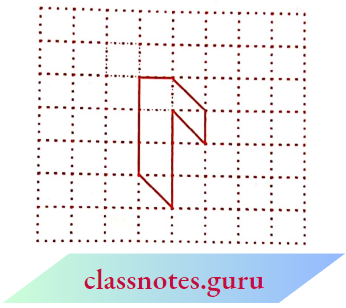
Fully-filled squares = 3
Half-filled squares = 3
Area covered by full squares = 3 x 1 sq units = 3 sq units
Total area = 4 1/2 sq units.
Example 2. By counting squares, estimate the area of the figure.
Solution: Make an outline of the figure on a graph sheet.


Total area = 11 + 3 x \(\frac{1}{2}\) + 7 = 19 \(\frac{1}{2}\) = sq units.
Example 3. By counting squares, estimate the area of the figure.
Solution: Make an outline of the figure on a graph sheet. This is how the squares cover the figure.
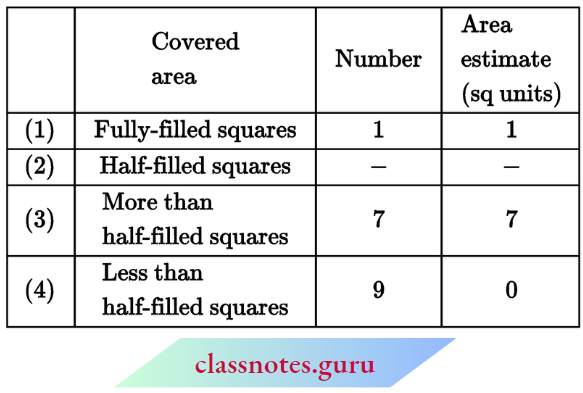
Total area = 1 + 7 = 8 sq units.
NCERT Notes For Class 6 Maths Area Of A Rectangle
With the help of the squared paper, can we tell, what will be the area of a rectangle whose length is 5 cm and breadth is 3 cm?
Draw the rectangle on a graph paper having 1 cm x 1 cm, squares. The rectangle covers 15 squares completely.
The area of the rectangle = 15 sq which can be written as 5 x 3 sq cm (length x breadth).
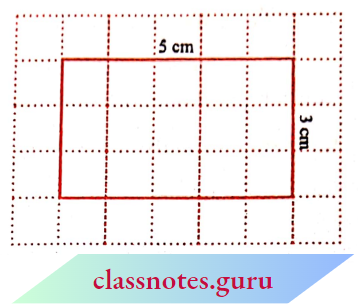
The measures of the sides of some of the rectangles are given. Find their areas by placing them on graph paper and counting the number of squares.
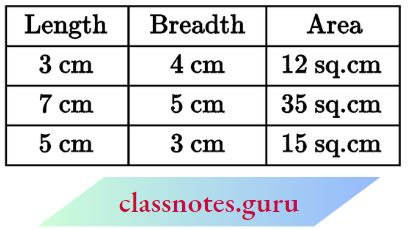
What do we infer from this?
We find,
Area of a rectangle = (length x breadth)
Without using graph paper, can we find the area of a rectangle whose length is 6 cm and breadth is 4cm?
Yes, it is possible.
What do we infer from this?
We find that,
Area of the rectangle = length x breadth = 6 cm x 4 cm = 24 sq cm.
NCERT Notes For Class 6 Maths Area Of A Square
Let us now consider a square of side 4 cm.
What will be its area?
If we place it on a centimetre of graph paper, then what do we observe?
It covers 16 squares i.e. the area of the square = 16 sq cm = 4 x 4 sq cm
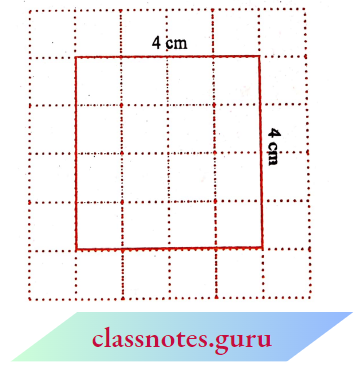
Calculate areas of a few squares by assuring the length of one side of the squares by yourself.
Find their areas using graph paper.
What do we infer from this?
We find that in each case,
Area of the square = side x side
You may use this as a formula for doing problems.
Example 1. Find the area of a rectangle whose length and breadth are 12 cm and 4 cm respectively.
Solution: Length of the rectangle =12 cm
Breadth of the rectangle = 4 cm
Area of the rectangle = length x breadth
= 12 cm x 4 cm = 48 sq cm.
Example 2. Find the area of a square plot of side 8 m.
Solution: Side of the square = 8 m
Area of the square = side x side
= 8 m x 8 m = 64 sq m.
Example 3. The area of a rectangular piece of cardboard is 36 sq cm and its length is 9 cm. What is the width of the cardboard?
Solution: Area of the rectangle = 36 sq cm
Length = 9 cm
Width =?
Area of a rectangle = length x width
So, width = \(\frac{\text { Area }}{\text { Length }}=\frac{36}{9}=4 \mathrm{~cm}\)
Thus, the width of the rectangular cardboard is 4 cm.
Example 4. Bob wants to cover the floor of a room 3 m wide and 4 m long with squared tiles. If each square tile is of side 0.5 m, then find the number of tiles required to cover the floor of the room.
Solution: The total area of tiles must be equal to the area of the floor of the room.
Length of the room = 4 m Breadth of the room = 3 m
Area of the floor = length x breadth = 4mx3m=12sqm
Area of one square tile = side x side = 0.5 m x 0.5 m = 0.25 sq m
Number of tiles required = \(\frac{\text { Area of the floor }}{\text { Area of one tile }}=\frac{12}{0.25}=\frac{1200}{25}=48 \text { tiles. }\)
Example 5. Find the area in square metres of a piece of cloth 1 m 25 cm wide and 2 m long.
Solution: Length of the cloth = 2 m
Breadth of the cloth = 1 m 25 cm = 1 m + 0. 25 m = 1.25 m (since 25 cm = 0.25m)
Area of the cloth = length of the cloth x breadth of the cloth = 2 m x 1.25 m = 2.50 sq m
